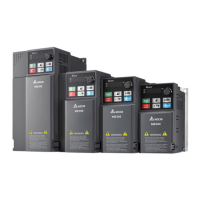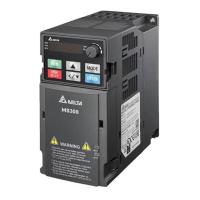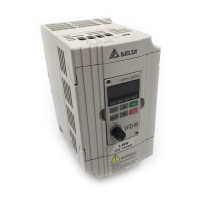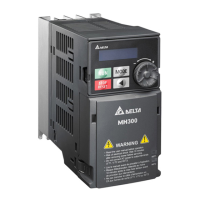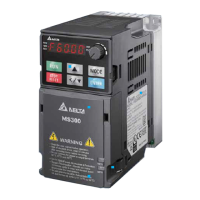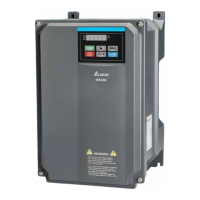Chapter 12 Description of Parameter Settings
ME300
When the operating point is greater than the derating curve, the carrier frequency (Fc) output
by the drive decreases automatically according to the ambient temperature, overload output
current and time.
Applicable conditions: If overloads are not frequent, and the concern is only about the carrier
frequency operating with the rated current for a long time, and changes to the carrier wave
due to short overload are acceptable, set to 0.
Take VFD9A0ME43ANSAA normal Duty for example: ambient temperature 50°C, UL Open
Type, and independent installation. When the carrier frequency is set to 10 kHz, it
corresponds to 75% of the derating ratio. When the output current is higher than the value,
it automatically decreases the carrier frequency according to the ambient temperature,
output current and overload time. At this time, the over-current stall prevention level is 150%.
Setting 1:
Actual over-current stall prevention level = derating ratio × over-current stall prevention level
(Pr.06-03 and Pr.06-04).
When the operating point is greater than the derating curve 1, the carrier frequency (Fc)
output by the drive is fixed to the default value.
Applicable conditions: Select this mode if the change of carrier frequency and motor noise
caused by ambient temperature and frequent overload are not acceptable. Refer to Pr.00-
17.
Take VFD9A0ME43ANSAA normal Duty for example: ambient temperature 50°C, UL Open
Type, and independent installation. When the carrier frequency is set to 10 kHz, it
corresponds to 75% of the derating ratio. When the output current is higher than the value,
the carrier frequency will not be reduced by this, but if the overload continues for a long time,
the oH1 fault (IGBT overheating) or oL fault (the inverter is overloaded) will be triggered due
to the IGBT temperature rise, and the motor will eventually stop.
The oL protection executes when the current is 120% × 75% = 90% for one minute; therefore,
it must operate by the curve to keep the carrier frequency.
Setting 2:
Actual over-current stall prevention level = derating ratio × over-current stall prevention level
(Pr.06-03 and Pr.06-04).
Rated current derating level: derating ratio × rated current (Pr.00-01).
The protection method and action are set to 0, but this disables the current limit when output
current is the derating ratio x 120% of output current in normal load, and derating ratio x
180% of output current in light load.
The advantage: it can provide a higher starting output current (Pr.06-55 = 0) when the carrier
frequency (Pr.00-17) setting is higher than the default value.
The disadvantage: the carrier frequency derates easily when it overloads.
For example: when Pr.06-55 = 0 or 1, the over-current stall prevention level = Ratio × Pr.06-
03. When Pr.06-55 = 2, the over-current stall prevention level = Pr.06-03.
Use with the settings for Pr.00-16 and Pr.00-17.
The ambient temperature also affects the derating; refer to Section 9-6 Derating for Ambient
Temperature, Altitude and Carrier Frequency.
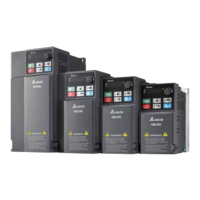
